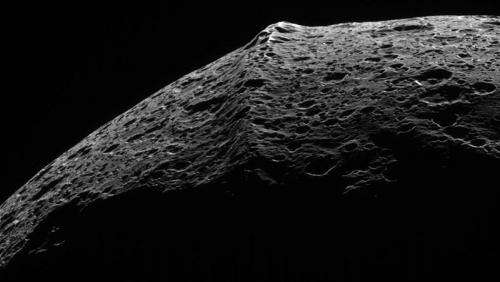April 21, 2014 report
Study of equatorial ridge on Iapetus suggests exogenic origin

(Phys.org) —A combined team of researchers from Brown University in Rhode Island and the Lunar and Planetary Institute in Texas is suggesting in a paper they've uploaded to the preprint server arXiv, that an equatorial mountainous ridge on one of Saturn's moons has an exogenic origin. They are basing their theory on 3D models of the moon they've created and an analysis of the types of peaks present.
Iapetus, the 3rd largest of Saturn's approximately 60 moons, is distinct for two reasons. One is its odd two-tone coloring; the other is the back-bone looking mountain range straddling part of its equator. Scientists have been puzzled by the origin of the mountain range as the moon doesn't have other geologic qualities that could have given rise to it, such as shifting plates or volcanic activity. Thus, some have suggested that the mountains came from above, rather than below, or in other words, they have an exogenic origin, meaning they came from somewhere else.
To gain a better understanding of the mountain range, the research team built a 3D model of it on a computer in their lab, faithfully replicating the 12 mile high by 12 mile wide by 800 miles long range in miniature, using data from the Cassini space probe. Once created, the team set to work measuring the shape of the peaks, which they believed should offer clues as to their origin. They found that the majority of the peaks sat in what is known as their angle of repose, which is the maximum angle at which material can rest on a peak without falling down to its base. Normal geologic activity tends to create peaks that are shallower and have less uniformity. This suggests, the researchers claim, that the mountains did not form due to geologic activity but more likely are part of a ring of material that once circled the moon and was pulled down to the surface.
A ring around the moon would most likely have come about due to a collision, either between another body and the moon, or two other bodies nearby. The resulting material would have formed a ring around the equator which over time, would have been pulled to the surface by gravity. Such a theory, the team notes, would also explain Iapetus's asymmetrical orbit and also why it orbits with the same face pointing at Saturn all of the time.
More information: Topographic Constraints on the Origin of the Equatorial Ridge on Iapetus, arXiv:1404.2337 [astro-ph.EP] arxiv.org/abs/1404.2337
Abstract
Saturn's moon Iapetus has an equatorial ridge system, which may be as high as 20 km, that may have formed by endogenic forces, such as tectonic and convective forces, or exogenic processes such as debris infall. We use high-resolution topographic data to conduct a topographic analysis of the ridge, which suggests a predominantly triangular morphology, with some ridge face slopes reaching 40 degrees, allowing for an exogenic formation mechanism.
Journal information: arXiv
© 2014 Phys.org





















